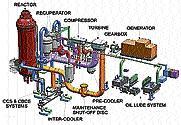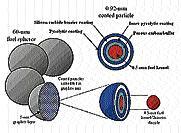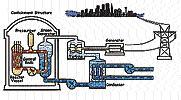Vallana Hill, Contributed





Nuclear power plants like their name derive their power from nuclear energy. Nuclear energy is energy in the nucleus (core) of an atom. Atoms are tiny particles that make up every object in the universe. There is enormous energy in the bonds that hold atoms together. Nuclear energy can be used to make electricity. But first the energy must be released. It can be released from atoms in two ways: nuclear fusion and nuclear fission. In nuclear fusion, energy is released when atoms are combined or fused together to form a larger atom. This is how the sun produces energy. In nuclear fission, atoms are split apart to form smaller atoms, releasing energy. Nuclear power plants use nuclear fission to produce electricity. The word
fission means to split apart.
An atom's nucleus can be split apart, by bombarding it with slow moving particles. When this is done, a tremendous amount of energy is released. The energy is both heat and light energy. This energy, when let out slowly, can be harnessed to
generate electricity. When it is let out all at once, it makes a tremendous explosion as in an atomic bomb.
This chain reaction gives off heat energy. This heat energy is used to boil water in the core of the reactor. So, instead of burning a fuel, nuclear power plants use the chain reaction of atoms splitting to change the energy of atoms into heat energy. This water from around the nuclear core is sent to another section of the power plant. Here it heats another set of pipes filled with water to make steam. The steam in this second set of pipes powers a turbine to generate electricity.
The Pressurised Water Reactor (PWR)
PWRs keep water under pressure so that it heats, but does not boil. Water from the reactor and the water in the steam generator that is turned into steam never mix. In this way, most of the radioactivity stays in the reactor area.
The Boiling Water Reactor (BWR)
BWRs actually boil the water. In both types, water is converted to steam, and then recycled into water by a part called the condenser, to be used again in the heat process. Since radioactive materials can be dangerous, nuclear power plants have many safety systems to protect workers, the public, and the environment. These safety systems include shutting the reactor down quickly and stopping the fission process, systems to cool the reactor down and carry heat away from it, and barriers to contain the radioactivity and prevent it from escaping into the environment. Radioactive materials, if not used properly, can damage human cells or even cause cancer over long periods of time.
Generation IV - The Pebble Bed Modular Reactor
The Pebble Bed Modular Reactor (PBMR) is a new type of high-temperature helium gas-cooled nuclear reactor that got its name from the type of fuel the reactor runs on, little tennis ball-size spheres with a uranium core and a ceramic coating.
Instead of 40,000 20-foot long rods, the fuel in the core is a bed of around 400,000 tennis ball-size 'pebbles'. These pebbles are continually removed through a pipeline at the bottom of the core. Pebbles whose fissionable uranium have been used up are discarded as spent fuel and new pebbles and are fed back into the top of the core. This system allows removal of spent fuel and replenishment of the core on a continuing basis. This not only cleans out spent fuel as it is produced, but also removes the need for fuelling the core at the outset with a huge excess of uranium that has to be kept inactive by control rods for months and years until its time comes to be 'burned'.
PBMR's are designed to produce 110MW each which means that 30, 000 average homes could be sustained by one such reactor. More than one PBMR can be located in a facility thus creating energy parks. It is possible for a PBMR energy park to be made up of a maximum of 10 modules which share a common control centre.
A single PBMR reactor would consist typically of a single main building, covering an area of 1,300 square metres (50 x 26 m) - about the size of an olympic swimming pool. The height of the building would be 42m, some of it ideally below ground level. The part of the building that would be visible above ground is equivalent to a six- storey building. There would be a unit control room, a high voltage switch yard, and a cooling tower for inland facilities and a sea pump house for coastal facilities. Ten PBMR reactors produce 1,100 MW would occupy an area of no more than three football fields.
These relatively small power stations would be versatile and flexible. They could be erected anywhere there is a steady and ready supply of water. They could be used as base-load stations or load-following stations, and could be adjusted to the size required by the communities they serve.
Waste
The design of the of PBMR fuel makes it easy to store the spent fuel, because the silicon carbide coating on the fuel spheres will keep the radioactive decay particles isolated for approximately a million years, which is longer that the activity even of plutonium.
The spent coated particle fuel can be disposed of in a deep under-ground repository. Coated particle fuel will maintain its integrity for up to - 1 million years in a repository, ensuring that spent fuel can be contained for extremely long periods of time. The plutonium will have decayed away completely in 250,000 years
Safety
The peak temperature that can be reached in the reactor core is far below any temperature that will damage the fuel. The reason for this is that the ceramic materials in the fuel such as graphite and silicone carbide - are tougher than diamonds. Even if a reaction in the core cannot be stopped by small absorbent graphite spheres or cooled by the helium, the reactor will cool down naturally on its own in a very short time. This is because the increase in temperature makes the chain reaction less efficient and it therefore ceases to generate power. The size and shape of the core is such that it has a high surface area to volume ratio. This means that the heat it loses through its surface faster than the heat generated by the decay fission products in the core. Hence, the reactor can never reach the temperature at which a meltdown would occur.
Chemical Leakage
The helium itself, which is used to cool the reaction, is chemically and radiologically inert: it cannot combine with other chemicals; it is non-combustible, and non-radioactive. Because oxygen cannot penetrate the helium, oxygen in the air cannot get into the high temperature core to corrode the graphite used in the reaction or to start a fire. The helium pressure inside the closed cycle gas turbine is higher than the air pressure outside it, so nothing can get inside the nuclear circuit to contaminate it.
Other Technological Innovations
The design of the PBMR has led to a higher power output with the same amount of nuclear fuel being used, and reduced the maintenance and operating requirements. Since the spent fuel us constantly being removed and replaced there is no need to shut the reactor down every 12-18 months to change the fuel as before. The use of a closed cycle gas turbine with helium and magnetic bearings is more efficient because gas turbines are more efficient than steam, and also with magnetic bearings there is less friction - this has reduced the major maintenance requirements to once every six years. All components are built as replaceable modules, so they are changed for spares which are then refurbished for the next machine. This shortens the maintenance periods significantly.
All these improvements enable the PBMR to be operated with little human intervention. The staff is there to monitor and supervise the plant rather than to operate it. All this means that PBMR's need fewer safety and fall-back systems, without compromising either worker or public safety. This also reduces the cost of building PBMRs and the time needed to plan, build and
commission them.
Nuclear power plants have come a long way since the Three Mile Island incident and the Chernobyl disaster that happened over three decades ago, severely halting the growth of the use of nuclear power plants across the globe. Advancements being made show this source to be much safer than several years ago, and more
efficient as well. With the renewed interest and hopefully sufficient funding and research, affordable energy without conflict may soon be a reality.
Sources:
http://en.wikipedia.org/
http://www.eas.asu.edu/~holbert/eee460/dfg/
http://www.pbmr.co.za/
http://www.solcomhouse.com/nuclear.htm

